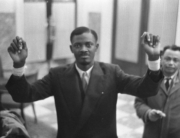Disturbing the Peace marks a decade in the struggle of Israeli military veterans and Palestinian ex-prisoners to work together for a viable solution after more than 60 years of strife in the land they uneasily share. Representing Combatants for Peace, eight participants face the camera to passionately explain how they came to accept the tenets of nonviolence and to empathize with the enemy. They believe that step one for any hope for peace is to recognize each other’s humanity.
Directors Stephen Apkon and Andrew Young first want the audience to see each as an individual. Borrowing Errol Morris’s interview technique for the lengthy heart of the film, the eight men and women (four Palestinian Muslims and four Israeli Jews) face the camera and tell their family histories (illustrated with archival footage and personal photos) and their own stories (seen in gray slo-mo reenactments), updated by news coverage of the continuing violent clashes. Each has a connection to the founding, and continuing, defense of Israel—the Jews, with relatives who were either early Zionists or displaced Holocaust survivors, and the Palestinians, who were either evicted in 1948 to refugee camps or chafed under Israel’s occupation of the West Bank since 1967.
The Israelis, from the young to those in their 40s, detail their proud service in elite units of the military, until a transformational realization—either in seeing the suffering of a child, particularly after retaliatory demolition of a terrorist’s home; or a comrade’s vicious beating of a suspect. They then joined the Courage to Refuse, an organization of soldiers who oppose the occupation and signed a commitment to refuse to serve in the occupied territories.
The Palestinians recall the anger that drove them to take up rocks or other weapons to attack Israelis and the years they served in Israeli prisons. Most were young teens; several sought revenge for friends or family killed by soldiers. Ironically, they used their prison sentences to learn for the first time about other conflicts around the world ameliorated by nonviolent leadership, from Gandhi to Nelson Mandela. Several on both sides also join the Bereaved Families Forum, composed of those who have been directly affected by violence and terrorism but who urge forgiveness over revenge.
These shared personal experiences mitigate the difficulties and establish trust in the face of Israeli checkpoints and the nervousness of being set up for an ambush. Video conferencing now helps them keep in touch. The cameras follow them on one of their controversial Memorial Day parades along the separation wall in memory of the deaths on both sides, provoking shouts of “Traitor” on one side and “Collaborator” from the other.
Besides encouraging this rare dialogue, Combatants for Peace’s website (and crowd-funding effort) presents other joint activities it undertakes that are not included here, such as building playgrounds, assisting families from demolished homes on the West Bank, and protesting encroachments on Palestinian property, all of which could have been more involving than just marches. (Not that it’s so easy for filmmakers to gain access either.)
These determined optimists have their work cut out for them to reach a plurality that can bring some version of the two-state solution back to negotiations. (Dan Setton’s State 194 from 2013 followed the debilitating disputes within the Palestinian Authority, and Shimon Dotan’s The Settlers, seen last month at the New York Film Festival, documented the expanding intransigence of the religious Zionists.)
Disturbing the Peace is being shown in New York and Los Angeles to qualify for Academy Award eligibility and will be released in more US theaters in February 2017.







Leave A Comment